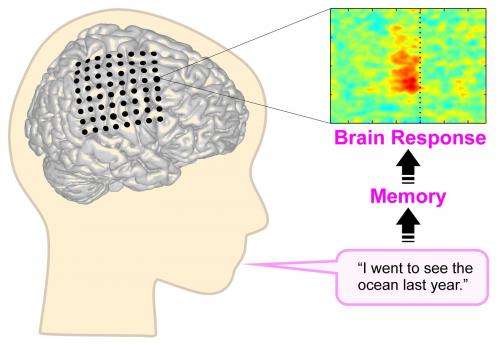Finding thoughts in speech

For the first time, neuroscientists were able to find out how different thoughts are reflected in neuronal activity during natural conversations. Johanna Derix, Olga Iljina and the interdisciplinary team of Dr. Tonio Ball from the Cluster of Excellence BrainLinks-BrainTools at the University of Freiburg and the Epilepsy Center of the University Medical Center Freiburg (Freiburg, Germany) report on the link between speech, thoughts and brain responses in a special issue of Frontiers in Human Neuroscience.
"Thoughts are difficult to investigate, as one cannot observe in a direct manner what the person is thinking about. Language, however, reflects the underlying mental processes, so we can perform linguistic analyses of the subjects' speech and use such information as a "bridge" between the neuronal processes and the subject's thoughts," explains neuroscientist Johanna Derix..
The novelty of the authors' approach is that the participants were not instructed to think and talk about a given topic in an experimental setting. Instead, the researchers analysed everyday conversations and the underlying brain activity, which was recorded directly from the cortical surface. This study was possible owing to the help of epilepsy patients in whom recordings of neural activity had to be obtained over several days for the purpose of pre-neurosurgical diagnostics.
For a start, borders between individual thoughts in continuous conversations had to be identified. Earlier psycholinguistic research indicates that a simple sentence is a suitable unit to contain a single thought, so the researchers opted for linguistic segmentation into simple sentences. The resulting "idea" units were classified into different categories. These included, for example, whether or not a sentence expressed memory- or self-related content. Then, the researchers analysed content-specific neural responses and observed clearly visible patterns of brain activity.
Thus, the neuroscientists from Freiburg have demonstrated the feasibility of their innovative approach to investigate, via speech, how the human brain processes thoughts during real-life conditions.
More information: Derix J, Iljina O, Weiske J, Schulze-Bonhage A, Aertsen A and Ball T (2014).. From speech to thought: "The neuronal basis of cognitive units in non-experimental, real-life communication using ECoG." Front. Hum. Neurosci. 8:383. DOI: 10.3389/fnhum.2014.00383. journal.frontiersin.org/Journa … .2014.00383/abstract
















